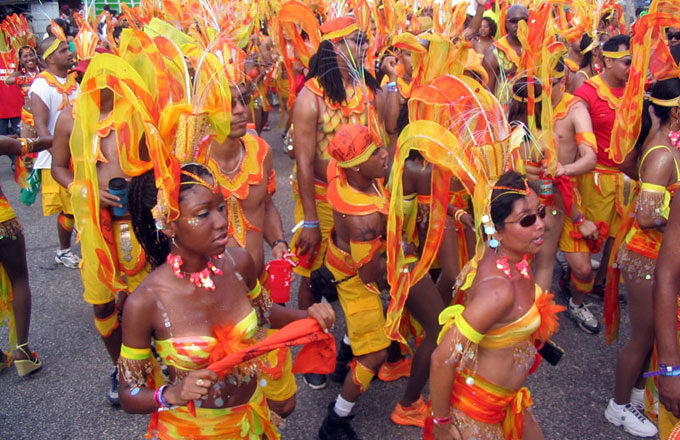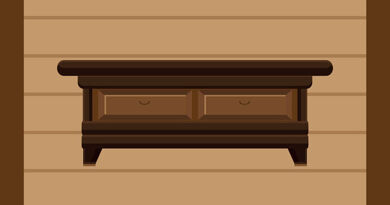Associations and carnival from 17th to 19th century
In the official correspondence, the word carnival appears in April 1722. As these festivities do not cause surprise, they are not new The administrators then criticize groups of wealthy whites by evoking two practices: the sumptuousness of certain meals, and especially a “Terrible game”.
In the same environment, at the start of the second half of the century, balls were added. At the same time, the other social groups must have their structures, lasting or ephemeral, because building, rebuilding, preserving links which go beyond the family framework are at the base of the movement which encourages meeting, drinking, eating, organizing networks of celebrations or mutual aid based on the perception that one has of one’s social level, belonging to a neighborhood, a dwelling, a profession, an ethnic group.
In the state of slavery, health, marriage, maternity, childhood, old age, incapacity, death being the responsibility of the master, the masses are concerned with religious and festive aspects. Articles 16 and 17 of the March 1685 edict prohibit slaves belonging to different masters from gathering by day or by night, under the pretext of weddings or otherwise, with their masters or on highways or remote places. Episodically, the recall of the law or the interest of a witness brings precious information.
Ethnic groups
From the middle of the 17th century, in his General History of the Antilles inhabited by the French, while he only mentioned Sundays and festivals, Fr. Du Tertre mentioned meetings of slaves “from the same land, or of those who are close to them “who eat together, sing in the fashion of their country and dance to the sound of” two calabashes filled with small rocks “, in other words chachas or a drum. Du Tertre does not speak of calendas or belair but “one of them holds this instrument between his legs, and plays it with his fingers (..) then when he has played a verse of the song, those who dance in sing another, thus continuing alternately as long as it lasts. ” These ethnic groups are also found at burials.
In 1850, two centuries later, in his Historical and Statistical Studies of Martinique, Doctor Rufz still evokes this type of grouping: “These peoples of Africa, transported to foreign shores, recognized each other, rallied, reformed the native tribe, and sought (..) to recall by their songs and their dances, the memories of the fatherland. These kinds of associations still exist today and are quite comparable to the associations that European workers form among themselves, to help each other with their illnesses and attend to their funerals. ”
It is not only a question of people born outside the island because in the middle of the 20th century, on the occasion of carnival, specific groups still brought together the grandchildren of immigrants from the second half of the 19th century.
Le Gaoulet from 1710
In July 1710, a settlement of accounts between whites led to the repression of a servile association formed in Saint-Pierre to “dance a certain dance which they called the gaoulet, which is to drop, get up, hit the stomach “. This festive association of illiterates from the Anchorage and the surrounding countryside is already characterized by its complexity. Mix of ethnic groups: Africans find themselves mixed with Creoles. Subversive participation of free white and colored, slaves belonging to twenty different masters. At their head, a general, like the governor general, not yet a king. Contributions, rites: the newcomer pays the ponche. Banquet: women cook. Sign of recognition: a coral necklace. On sale: the inevitable “cord” or “condom” which allows you to go home without being punished when you have left in marronnage, and to fight without being injured.
Church and carnival
Quimbois therefore, but the Church is always present. The carnival is located between Kings and Lent. Blessed bread, weddings, funerals, processions are occasions for meeting followed by meals, songs and in some cases, dances. The association of 1710 has had its headquarters for several months on the housing of the Ursulines. Let us also think of the cure of “negroes” in an urban environment and of brotherhoods. The first link with the danger of poisoning appeared in Santo Domingo, in 1758, during the Macandal affair. In the small suspected packages we find incense and blessed bread mixed with various objects. At funerals: feasts, “mourning consisting of dressing in white for several days and carrying the handkerchief folded in half-handkerchief, the two ends hanging from behind”.
In 1752, in Martinique and Guadeloupe, the festivities of the Fête Dieu were of considerable magnitude. All the parishes affected are not mentioned and the accent is put on the rivalry in Saint-Pierre between the Fort and the Anchorage: “dressed in very rich clothes”, slaves represent the King, the Queen, the whole royal family . In a church, the king and queen having been placed in armchairs “the negroes had the honors” and, even more subversively, the whites were “confused”, mixed with them. For these reasons, the brotherhood entitled: The Slavery of the Blessed Virgin is prohibited. Nevertheless, in 1774, slaves were still enjoined to attend the processions in their ordinary clothes and, in 1801, at Robert, a brotherhood built an oratory bearing the inscription Support of the slaves pray for us.
Convoys to flower companies
On the eve of the carnival of 1784, the Martinican ordinance of December 25, 1783 recalls the ban on slaves belonging to different masters from meeting without the permission of the procureur du roi. Free people are just as concerned. With the Revolution, politics entered. Following the failure of the expedition organized by Victor Hugues against Martinique, the ordinance of October 30, 1795 provides important details. Associated with free “under specific names”, slaves wear “convoys or burials” ribbons and other distinctive marks in silver gold or other materials. In January 1797, anyone of any quality and condition was made to appear in the masked and disguised streets during the carnival. In November 1809, a new ban evoked masses, blessed breads and extraordinary luxury in funeral convoys.
On the eve of the 1830 carnival, when Martinique is troubled by the question of the reform of the slave society, a great debate, which takes place in the Privy Council, reveals that the prohibitions have been useless. There are 17 such associations “formerly known as convoys” at Fort-Royal, no doubt more, we are told, at Saint-Pierre. They also exist in towns and the countryside. We already knew the ribbons of different colors. We added names: society of roses, carnations etc. Each association has its flag, in other words its banner, its king, its queen, its treasurer … They correspond to each other and recently, at the instigation of people of free color, who obviously also have their associations, they all gathered at Fort-Royal for a funeral.
In 1736, this kind of association existed at least on the island of Antigue. In the British colonies, the equivalent of carnival takes place at the end of December.
In Jamaica, as early as 1774, ethnic groups were described with their particular music, groups of trades and plantations. After 1794, the emigrants from Santo Domingo appeared. These associations are distinguished by their colors: “golden”, “velvet”, “garnets”. They have their John Canoe, their kings, queens, compete with their songs and dance little sketches often linked to current events.
In Saint Lucia, where the Rose opposed the Marguerite, August 30, the anniversary of Saint Rose of Lima, is still celebrated with kings, queens, soldiers, pages, parades, dances, dinners and song contests .
We do not know when the songs and sketches linked to the news appear in Saint-Pierre, but in February 1831, on the occasion of the riots, a witness evokes “songs which they sang with frenzy in the streets and on the public places and in which they insulted M. de Freycinet, former governor and invited MM de Perinelle and de Sanois, notable inhabitants to cart water to put out the fire ”. For his part, the governor writes that the Sunday meetings, tolerated for the dances “disturbed order and tranquility by the songs” and that he closed “the courtyards in which these scenes took place”.
From Mardi Gras to Ash Wednesday
Under Napoleon 1 st, the colonial prefect Laussat did not disdain leaving accounting and politics to describe the carnival festivities.
The whites he frequents combine to give balls. Those of the Fort, who pride themselves on nobility, do not commit themselves with those of the Anchorage. In a ball in this last parish, on mardi gras, most women “disguised themselves as mulattos.” The men are also disguised, their faces uncovered. It remains to be seen whether women simply wear masks. Here, for “three days”: Saturday, Sunday, Monday, the “dancing dancers” had “only gone to bed in the rising sun”. On Wednesday morning, he leaves them “resolved not to close the carnival until the ash mass”. It is already a use that does not shock. A third group “a little lower” subscribed to organize a nightclub, the first we know: the Terpsychore, named after the muse of dance.
It is certainly the same for free people of color. But Laussat seems to be only interested in slaves, known as negroes, since he evokes “the river bamboula where negroes are in the habit of saying goodbye to carnival”, the afternoon of Ash Wednesday. In 1830, Europeans still wrote bamboulas. In 1840, Dessalles dit belairs.
“In use” indicates that this is not an innovation. The demonstration does not take place in town but on the banks of a river. The participants are numerous and constitute distinct groups: groups of drums “dancing bamboulas”, groups of violins attested by “the contredanses”, group of flute players. Beyond the divisions of social status, trades and district which, for the drums, can already be also linked to the courses, there was concertation to obtain the authorization of the authorities and fix the place, this time, in the heights of the Pères river. And, for there to be “crowds of negroes”, at least half a day must be idle.
The ensemble: music, dances and meals, gives a real spectacle which attracts the whites of the city and the surroundings. Nothing is said about the costumes, but Laussat sees participants “feasting on tablecloths covered with big dishes and black sauces”. No meat or even fish. A meal of Lent. In addition, the main dishes evoking vegetables, and the other possible basic elements being cassava flour and rice, we probably have a black and white meal.
In the countryside, we mostly spot allusions about associations but don’t forget the links between the festive and the religious. Our most abundant information being taken from the journal of Pierre Dessalles, resident of Sainte-Marie, only the internal solidarity between the dwelling and from dwelling to dwelling are highlighted.
The owner opens his house to the slaves, offers drinks, food and, if necessary, pays the violins. He can just observe. More often, he gathers a few friends around a meal. On Sunday January 29, 1837, the festivities took place at Dessalles in the New City: “My servants made people dance; I gave them a sheep and a few bottles of wine. Lalanne and Pierre Cardin had dinner with me. Louis Le Vassor and M. Cicéri came to watch the dance. At 9 a.m., the dance stopped, and at 11 a.m. supper ended. Hidden in a corner, I saw everything without being seen: nothing seemed more pleasant to me. The meal finished, we sang, the tone, the inflections of voices, everything came together to excite laughter. I had to stand at four so as not to burst. I observed that the greatest politeness had existed (..) Many of Mr. de Survillie’s negroes were at this feast. I had the opportunity to notice pretty negresses. ”
Then come the Fat Days. On Saturday February 4, Dessalles dines in Limbé with the heirs Le Vassor and the slaves dance. On Fat Tuesday, he leaves the afternoon in his workshop and gives syrup and tafia. He observes, on the one hand: that several were disguised, “dressed a man of straw and walked him to the sound of the horns”, and on the other, that the dance stopped at midnight.
In 1840, for the Fat Days, Saturdays and Sundays, the party again united his workshop and that of Survilliée. She resumes Monday evening with other neighbors. Without being moved, Dessalles remarked that “many free people came to see and even danced with the slaves”. This year, in addition to the counter-dances, he evokes the belairs, and insists on the drum which, on Mardi Gras, beats from five in the afternoon until daybreak.
Between 1837 and 1840, there was certainly no evolution. At least, we feel that the uses of the countryside join those of the city.
Léo ELISABETH




